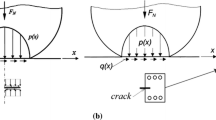Abstract
Fatigue threshold under mixed-mode I and II loading and elastic plane-strain conditions has been studied in dual-phase steels (DPS) of two types of volume fraction of martensite (Vm) in laboratory air at room temperature. Near-threshold mixed-mode (I and II) fatigue crack growth occurs mainly by two mechanisms: shear mode, and tensile mode. Particular emphasis was placed on the influence of the mode II component. The mixed-mode threshold is controlled not only by mode I displacement but also by the mode II component. Apparent- and effective-bound curves (corrected closure) are obtained for the threshold condition and discussed in terms of the shape and size of the plastic region of crack tip; crack surface rubbing; and especially, roughnessinduced closure and shear resistance of crack surface that resulted in an extremely high extrinsictoughening contribution to the mixed-mode fatigue threshold values. The ratio of the threshold value of pure mode II to that of pure mode I (ΔK thII/ΔKththI) attained highly to 1.9 times; the maximum hoop direction stress-intensity factor range of pure mode II branch crack tip is 2.2 times that of pure mode I. Obviously, the resistance of pure mode II crack growth here is far larger than that of pure mode I; the former is just to introduce the shear resistance of crack surface, the latter, to reduce the driving force of crack tip for crack closure. It is proposed that the apparent- and effective-bound curves are nonconservative risky and too conservative for design purposes, respectively. So, the threshold data should be obtained under the specific conditions found by concrete mechanical, microstructural, and environmental factors.
Similar content being viewed by others
References
M.W. Parson and K.J Pascoe:Mater. Sci. Eng., 1976, vol. 22, pp. 31–50.
.J. Miller:Met. Sci., 1977, vol. 11, pp. 432–38.
K. Ohji, K. Ogura, S. HarActa, and H. Senga:Bull. JSME, 1974, vol. 17, pp. 32–40.
M.W. Brown, and K.J. Miller:Proc. lnst. Mech. Engr., 1973, vol. 187, pp. 745–55.
Takeo Yokobori, Asamichi Kamei, and A. Toshimitsu Yokobori:Int. J. Fract., 1976, vol. 12, p. 158.
A. Toshimitzu Yokobori, Jr.,Takeo Yokobori, Kiyoshi Sato, and Kazuo Syoji:Fatigue FraC.T. Eng. Mater. Struct., 1985, vol. 8 (4), pp. 315–25.
E.K. Tschegg:Mater. Sci. Eng., 1982, vol. 54, pp. 127–36.
K.N. Akhurst, T.C. Lindley, and K.J. Nix:Fatigue Eng. Mater. Struct., 1983, vol. 6 (4), pp. 345–48.
J.L. Horng, and M.E. Fine,Scripte Metall., 1983, vol. 17, pp. 1427–30.
H. Gao, M.W. Brown, and K.J. Miller:Fatigue Eng. Mater. Struct., 1982, vol. 5 (1), pp. 1–17.
H. Gao, E.R. delos Rios, and K.J. Miller:Eng. Mater. Struct., 1983, vol. 6 (2), pp. 137–47.
L.P. Pook:Int. J. Fatigue, 1985, vol. 7 (1), pp. 21–30.
J.P. Yates and K.J. Miller:Mater. Struct., 1989, vol. 12 (3), pp. 259–70.
L.P. Pook and J.K. Sharpies:Int. J. FraC.T., 1979, vol. 15, p. R223.
H. Suzuki and A.J. McEvily:Metall. Trans. A, 1979, vol. 10A, pp. 475–81.
K. Minakawa, Y. Matsuo, and A.J. McEvily:Metall. Trans. A, 1982, vol 13A, pp. 439–45.
V.B. Dutta, S. Suresh, and R.O. Ritchie:Metall. Trans. A, 1984, vol. 15A, pp. 1193–1207.
Jian Ku Shang, J.-L. Tzou, and R.O. Ritchie:Metall. Trans. A, 1987, vol. 18A, pp. 1613–29.
R.M. Ramage, K.V. Jata, G.J. Shiflet, and E.A. Starke, Jr.,Metall. Trans. A, 1987, vol. 18A, pp. 1291–98.
D.L. Chen, Z.G. Wang, X.X. Jiang, S.H. Ai, and C.H. Shih:Mater. Sci. Eng., 1989, vol. A108, pp. 141–51.
Y.S. Zheng, Z.G. Wang, and S.H. Ai:C-MRS Inter. ’90, June 18–22, 1990, Beijing, People’s Republic of China, vol. 5, p. 257.
K.J. Wang, C.L. Hsu, and H. Kao:Proc. ICF4, 1977, Pergamon Press, New York, NY, vol. 4, pp. 123–33.
W.F. Brown and J.E. Srawley:Plane Strain Crack Toughness Testing of High Strength Metallic Materials, ASTM STP 410, 1966, pp. 1–65.
W.K. Wilson:Eng. Fracture Mech., 1970, vol. 2, pp. 169–71.
J.P. Benthem and W.T. Koiter:Methods of Analysis and Solution to Crack Problems, G.C. Sih, ed., Noordhoff, Leyden, The Netherlands, 1973, pp. 131–78.
F. Erdogan and G.C. Sih:J. Basic Eng., 1963, vol. 85, pp. 519–27.
T.M. Maccagno and J.F. Knott:Eng. FraC.T. Mech., 1989, vol. 34 (1), pp. 65–86.
K. Tanaka:Eng. FraC.T. Mech., 1974, vol. 6, p. 493.
K. Hyashi and S. Nemat-Nasser:J. Appl. Mech., 1981, vol. 48, pp. 520–24.
G.C. Sih:Int. J. FraC.T., 1974, vol. 10, pp. 305–21.
M.W. Brown, H.W. Liu, A.P. Kfouri, and K.J. Miller:ICF5, Pergamon Press, New York, NY, 1980, vol. 2, p. 891.
T.M. Maccagno and J.F. Knott:Int. J. FraC.T., 1985, vol. 29, pp. R49-R57.
H.A. Richard:Proc. 6th Int. Conf. on FraC.T., New Delhi, Pergamon Press, Oxford, 1984, vol. 5, pp. 3337–44.
R.J. Sanford and J.W. Daily:Eng. FraC.T. Mech., 1979, vol. 11, pp. 621–33.
D.L. Jones and D.B. Chisholm:Eng. FraC.T. Mech., 1975, vol. 7, pp. 261–70.
C.F. Shih:Small Scale Yielding Analysis of Mixed Mode Plane Strain Crack Problems, ASTM STP, 560, 1974, pp. 187–210.
S. Aoki, K. Kishimoto, T. Yoshida, and M. Sakata:J. Mech. Phys. Solids, 1987, vol. 35 (4), pp. 31–55.
R.P. Wei and J.D. Landes:Mater. Res. Std., ASTM 9, 1969, vol. 25.
R.P. Wei and M. Gao:Scripta Metall., 1983, vol. 17, p. 959.
H.W. Liu:Fatigue FraC.T. Eng. Mater. Struct., 1985, vol. 8 (4), pp. 295–313.
A. Otsuka, K. Mori, and T. Miyata:Eng. FraC.T. Mech., 1975, vol. 7, pp. 429–39.
Y.S. Zheng: Ph.D. Thesis, Institute of Metal Research, Academia Sinica, Shenyang, People’s Republic of China, 1992.
Author information
Authors and Affiliations
Additional information
Y.S. ZHENG, Formerly Ph.D. Student, State Key Laboratory for Fatigue and Fracture of Materials, Institute of Metal Research, Academia Sinica, Shenyang, 110015, People’s Republic of China
Rights and permissions
About this article
Cite this article
Zheng, Y.S., Wang, Z.G. & Ai, S.H. Mixed-Mode I and II fatigue threshold and crack closure in dual-phase steels. Metall Mater Trans A 25, 1713–1723 (1994). https://doi.org/10.1007/BF02668536
Received:
Issue Date:
DOI: https://doi.org/10.1007/BF02668536




